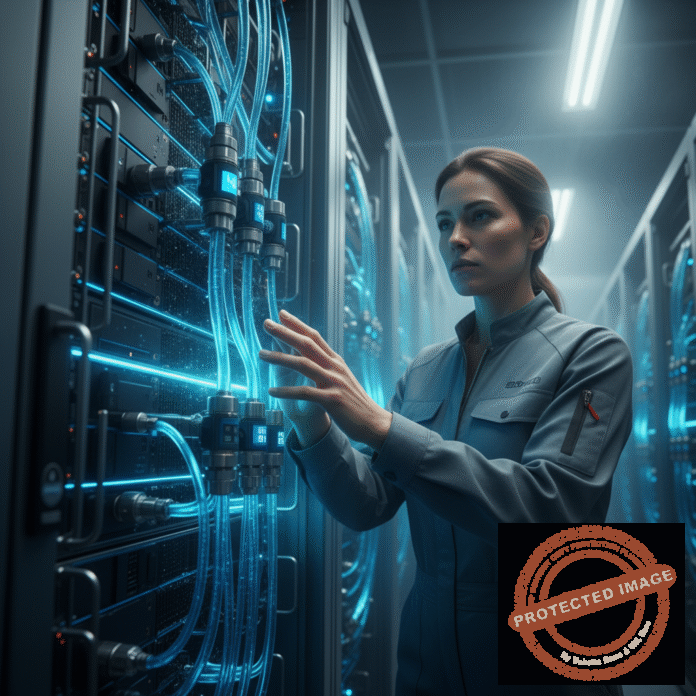“From NPUs in laptops to GPU-heavy servers, specialized hardware is rapidly becoming ubiquitous across enterprise AI compute environments.”
The era of generic CPUs handling everything—from email to large-scale AI workloads—is giving way to a finely tuned hardware ecosystem optimised for AI. At the core of this shift are Neural Processing Units (NPUs) and Graphics Processing Units (GPUs), each addressing critical gaps in AI compute performance. NPUs are purpose-built for neural network inference and edge-AI workloads; GPUs remain the workhorses for training and large-scale batch inference. ServerMania+2MDPI+2
Recent research comparing server platforms showed that NPU-based configurations can deliver superior inference latency/throughput for real-time AI tasks such as multimodal understanding or detection than GPU-only systems. MDPI Meanwhile, major vendors such as AMD are signalling discrete NPU products to rival GPUs, especially for PCs and laptops. TechSpot+1
All of this points to a future where buying a “normal” laptop or a standard server without AI acceleration may become difficult by 2026; AI-enabled compute is rapidly becoming the baseline expectation.
AI PCs and enterprise laptops
In the PC and workstation world, NPUs are being embedded into system-on-chips (SoCs) or as discrete accelerators. These enable local AI capabilities (on-device inference, real-time models) without relying exclusively on cloud connectivity. For enterprise laptops and workstations, this means:
-
Local AI features such as instant transcription, intelligent assistance, image/video editing, AI-driven simulation, and more.
-
Lower latency and improved privacy as models and inference run on-board rather than in the cloud.
-
Emerging vendor requirement: if a device lacks dedicated AI acceleration (NPU + GPU), it may be viewed as legacy.
For IT procurement teams, it means that when negotiating with OEMs (e.g., Dell, HP, Lenovo) the ask is shifting: “Does this laptop support NPU acceleration, GPU-AI inference, driver and SDK stack for AI workloads?” Gone are the days when a basic integrated GPU sufficed.
GPU-accelerated servers for large-scale AI
At the server and data centre level, the demand profile is similarly evolving. Large-scale training and inference tasks continue to rely heavily on GPUs (e.g., Nvidia, AMD) paired with large memory and fast interconnects. But the story now includes hybrid GPU-NPU configurations as well, and increasingly, server architectures optimised for AI from the ground up.
Among the key drivers:
-
Enterprises scaling out model training and large multimodal systems demand compute density and throughput.
-
Inference workloads at the edge and cloud require efficient hardware; NPUs help reduce power and latency.
-
Data centre operators emphasise performance per watt and per dollar. NPUs offer improved efficiency in many real-time tasks. Patsnap Eureka+1
From the viewpoint of your enterprise or IoT/robotics engagements, this trend means you might need to influence your hardware strategy: when proposing solutions like AI-enabled workstations or servers for client engagements, ensure the specifications include NPU/GPU components supported by software and SDKs.
Implications for buyers, integrators and vendors
For buyers (enterprises, government, large accounts) the implications are:
-
The procurement baseline must change. When issuing RFPs for laptops/workstations, include an AI-acceleration clause: NPU + GPU support with SDK/driver ecosystem.
-
For servers, include AI workload KPIs (model training hours, inference latency, throughput, energy cost per inference), not just classical CPU metrics.
-
Vendors that do not support NPU/GPU innovation risk being sidelined; OEMs must partner with AI-compute chipset vendors and provide full-stack support (hardware, firmware, and AI frameworks).
-
From a services-and-solutions perspective, when you (in your role with IBM Sterling/Maximo/IoT) are advising clients, call out the hardware layer explicitly: how many NPUs, how many GPUs, what architecture, and what SDK/support?
Challenges and caveats
Of course, adoption of NPUs and GPU-AI hardware does not come without headaches:
-
The software ecosystem must catch up: drivers, frameworks, optimization tools, firmware updates. Without good ecosystem support, the hardware sits idle.
-
Integration/lifecycle costs: AI-enabled hardware often means additional thermal, power, and cooling demands (which we’ll address in other articles).
-
Buyer education: Many enterprise buyers are still laptop or server-centric and judging purely on CPU/GPU specs; getting them to evaluate NPU acceleration, model inference/throughput benchmarks is a change management task.
Closing Thoughts and Looking Forward
The dominance of specialized AI hardware—NPUs for on-device edge/desktop inference, GPUs for high-scale training, and hybrid modes—is rapidly reshaping the compute landscape. Enterprises, integrators, and OEMs must shift purchasing and design mindsets accordingly. From your vantage point as an advisor/brand specialist, this is a major opportunity: help clients map hardware (servers + workstations + laptops) directly to AI-use-cases, benchmarks, and lifecycle costs. Over the next 18-36 months, a hardware refresh wave is likely as “AI-enabled” becomes the new standard.
Author: Serge Boudreaux – AI Hardware Technologies, Montreal, Quebec
Co-Editor: Peter Jonathan Wilcheck – Miami, Florida
Reference sites
-
“Performance and Efficiency Gains of NPU-Based Servers over GPUs for AI” — Systems (MDPI) https://doi.org/10.3390/systems13090797 MDPI
-
“NPU vs GPU: Guide to AI Acceleration Hardware” — ServerMania KB https://www.servermania.com/kb/articles/npu-vs-gpu-comparison-guide/ ServerMania
-
“AMD signals push for discrete NPUs to rival GPUs in AI-powered PCs” — TechSpot https://www.techspot.com/news/108894-amd-signals-push-discrete-npus-rival-gpus-ai.html TechSpot
-
“Neural Processing Units: Revolutionizing AI Hardware” — MicrochipUSA article https://www.microchipusa.com/electrical-components/neural-processing-units-revolutionizing-ai-hardware Microchip USA
-
“Navigating the Future of AI Compute: GPUs, NPUs, and the Cost of Innovation” — HackerNoon https://hackernoon.com/navigating-the-future-of-ai-compute-gpus-npus-and-the-cost-of-innovation Hacker Noon
Post Disclaimer
The information provided in our posts or blogs are for educational and informative purposes only. We do not guarantee the accuracy, completeness or suitability of the information. We do not provide financial or investment advice. Readers should always seek professional advice before making any financial or investment decisions based on the information provided in our content. We will not be held responsible for any losses, damages or consequences that may arise from relying on the information provided in our content.



